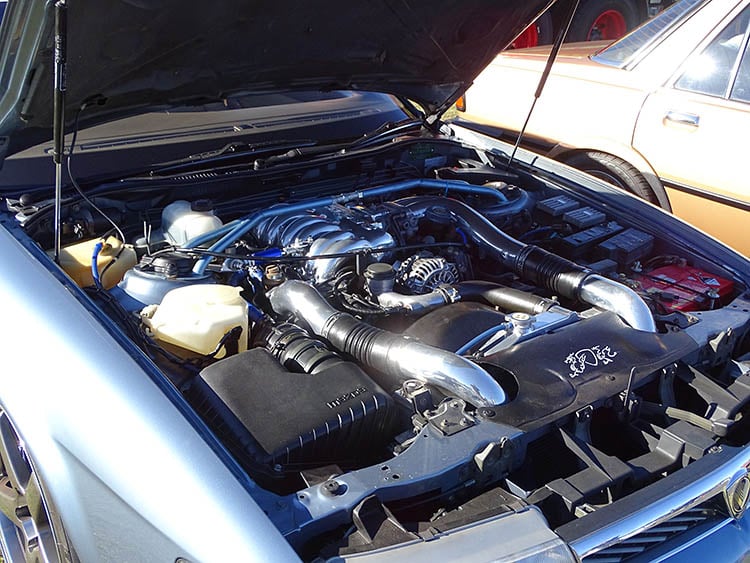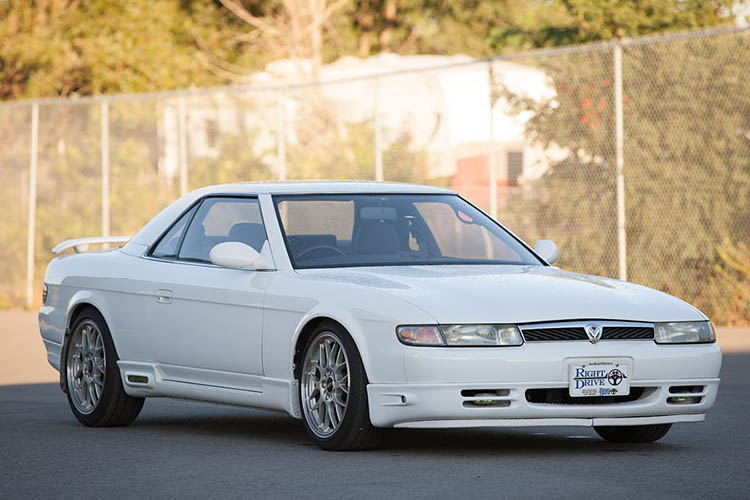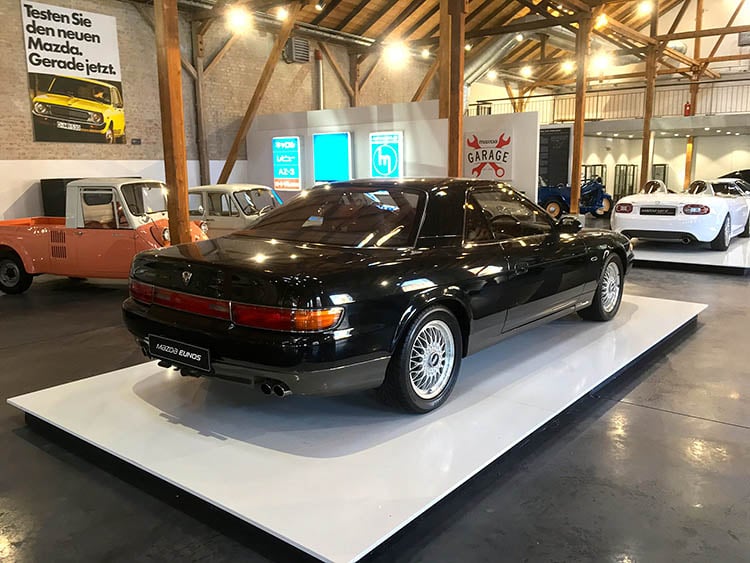Ultimate Mazda 20B Engine Guide
Move over 13B – it’s 20B’s time to shine! We’re taking an in-depth look at everything there is to know about Mazda’s legendary 3-rotor.

- Introduction
- What Is A 20B?
- 20B Engine Specs
- Which Cars Have The 20B Engine?
- How Much Is A 20B?
- Upgrades & Tuning Potential
- Reliability & Common Issues
- 20B Engine Swaps
- Conclusion
Introduction
When the Mazda Eunos Cosmo debuted in 1990, it became the first (and last) production Mazda to utilize the highly sought-after triple-rotor 20B-REW engine.
With Mazda continuously improving upon their first attempt at the rotary engine, with the 1960’s L10 Cosmo, the Cosmo has gone on to feature the immensely sought-after 2-rotor 13B, and 3-rotor 20B engines throughout its lifetime.
Not only was the 20B revolutionary for being the world’s first production engine to include a twin-sequential turbo system, but its improved torque output and increased displacement often make the 20B the most sought-after rotary on the market.
As the “No replacement for displacement” statement rings true once again, it’s time to consider whether the 20B is the ultimate rotary engine for your next engine swap.
Let’s take a look as we dive into everything you could ever want to know about the much-loved Mazda 20B rotary engine.
What Is A 20B?
Mazda’s impressive 20B engine is the only 3-rotor production motor sold by the manufacturer.
Although Mazda’s 13B-REW is often the most sought-after rotary for engine swaps, this is partly down to the rarity of the 20B, with the twin-turbo variant only ever sold within the JDM (Japanese Domestic Market) under the hood of just one car in their range.

If you think it’s hard to get a 20B-REW, then try getting your hands on the 20B racing engine, which was never sold under the hood of a production model.
While the infamous 13B is undoubtedly an incredible engine, the increased displacement and additional rotor with the 20B allow for much-improved torque, where the 13B lacks, and far less stress when it comes to higher-output potential thanks to the additional displacement.
The 20B was the only mass-produced 3-rotor engine, but there’s an earlier equivalent to the naturally aspirated 20B race engine, which never hit the mass market – the 13G.
Mazda 13G
Mazda introduced their first 3-rotor engine to the public in 1984, found in the Mazda 757 Le Mans racer.
Utilizing the rotary’s design, Mazda opted to stack multiple 13B housings, giving birth to the idea for both the 3-rotor (13G, 20B) and four-rotor (26B) engines.
The impressive thing is that this mostly allowed Mazda to use the existing parts without significant redesigns but with far greater output with significantly reduced stress thanks to the extra displacement. The main cost factor ended up being the required production of an elongated eccentric shaft for the 13G.
With the design finalized, it produced 440 hp at 8,500 rpm and 400 nm torque at 8,000 rpm, and despite the insane power, it weighed in at just 143kg, which was extremely impressive for its time.
Unfortunately for the 757, it didn’t have the best introduction to motorsport, with both Mazdaspeed 757’s receiving a DNF with transmission failure during the 1986 24 Hours of Le Mans.
Thankfully, with the issues ironed out, it went on to receive plenty of success over the next couple of years, as Mazda considered the idea of bringing a similar variant to the mass market.
As Mazda began testing ideas, the dry-sump 13G initially featured under the hood of the Mazda MX-03 concept car, which never reached the market, but undoubtedly inspired the JC Eunos Cosmo.
Although the 13G was fantastic for racing purposes, the high-revving 13G didn’t utilize the powerband in an ideal way for everyday use, with peak torque coming into play at 8,000 rpm.
Mazda 26B
Alongside the 13G, Mazda later had the most incredible rotary of all-time, the 787B’s four-rotor 26B to consider bringing to the mass market.
Having eventually had incredible success in Le Mans, combined with one of the most insane engine sounds ever heard, a road-legal 26B would undoubtedly be every petrolhead’s dream.
Sadly, due to incredibly-high production costs, the far more complex 26B wasn’t viable for mass-production, where the 13G and 20B are the more reasonable, yet still fantastic, alternatives.
Mazda opted to stick with the 13G design while utilizing twin-turbos to make the most of the powerband.
After strapping on twin-turbos, they decided to make the engine code coincide with the rest of their lineup - the 20B was born.
Production 20B
With the 20B-REW being the viable option for mass-production, Mazda decided to feature the highly-desirable engine in an unsuspecting ‘halo’ car - the JC Eunos Cosmo.
The Cosmo’s 3-rotor 20B-REW engine features 654 cc (39.9 cu in) per rotor, spread over three chambers, with a total displacement of 1,962 cc (119.7 cu in) with the “20” in the name now referring to its 2.0L capacity.
As the three-rotor 20B-REW engine hit the market for the first time in 1990, it became the first-ever twin-turbo-powered car and the only three-rotor engine ever to reach mass production.
Racing 20B
Alongside the production of the 20B-REW, Mazdaspeed Japan and Mazda Motorsports USA both also sold the 20B racing engine.
Although the natural assumption is that the race engine is based on the 20B-REW, it appears to be more of a re-branded 13G, with near-identical specifications and power outputs, as well as the stock dry-sump.
Racing 20B’s occasionally pop up on the market, so if you’re after something even more unique than the 20B-REW, it could potentially be an exciting alternative.
R20B RENESIS
Racing Beat produced a later version of the engine, known as the ‘R20B RENESIS’ for the Furai concept car, unveiled in December 2007.
Despite high hopes for the R20B, the ethanol-powered 20B caught fire during a Top Gear photoshoot, and with the team failing to control the fire, the exciting project sadly turned to ashes.
It wasn’t until 2013 that the demise was known, with Top Gear publishing photos of the Furai’s charred remains later that year.
20B Engine Specs
Many believe that Mazda used the 20B-REW as a test to see how the engine fared with daily usage, potentially considering utilizing the 20B for the far more popular RX7.
It’s no secret that the 20B-REW has many similarities to the much-loved 13B, with many shared components between the two, with the main differences being a second intermediate housing and the 3-rotor eccentric shaft.
Mazda sold the Eunos Cosmo between February 1990 and September 1995. With the Cosmo featuring the 20B-REW and a 13B variant, 4,000 20B-REW models left the showroom during these five years.

During the five-year Cosmo sale period, several variations of the 20B sold, with each revision identifiable by their engine numbers.
With the initial engines numbered 000-999 or A000-A999, these suffered from fatal housing issues almost immediately and eccentric shaft failure, rectified with a rebuild under Mazda warranty.
Mazda later went on to roll out the B000-B999 and C000-C999 engine codes, which featured a reinforced housing to correct the initial issues.
The final runs were D000-D999, and E000-E999, with E-numbers likely reserved for Mazda-specific purposes and engine replacements.
Series 1 Cosmo (90-92) engines have silver intake manifolds, and Series 2 Cosmo (93-95) engines have black intakes.
20B-REW Turbo Design
The 20B’s revolutionary twin-turbo design meant that the first, smaller turbo would spool quickly to eliminate turbo lag as much as possible.
As the second turbo spooled up in the background, lying in wait, it would then be unleashed from 3,500 rpm and beyond, with the turbos eventually reaching 10 psi.
The dual-exhaust design allowed the gases to flow to the dual, twin-exit exhaust pipes at the rear, with two open at all times, with the remaining two fully-opening under heavy throttle to allow the 20B to sing to its full capabilities.
Eunos Cosmo Transmission
One of the first things to go for most potential 20B-REW owners will be the Cosmo’s 4-speed automatic gearbox.
Although the fancy four-speed had more world-first claims, with a manual selection capability within the first three gears, a ‘PWR’ button enabled a sportier mode, allowing for higher-rev gear changes.
Unfortunately, the transmission restricted the engine to 7,000 rpm rather than its proven 9,000 rpm capabilities. But, let’s face it, you wouldn’t keep the outdated auto box if you were opting for a 20B-REW anyway!
Questionable Power Figures
As with many of the Japanese “gentlemen’s agreement” engines at the time, the 20B-REW supposedly has more power than its factory stats claim.
With a supposed 276 hp in stock form, many claimed this was significantly higher than initially stated, with actual figures likely to be nearer 300 hp, with some claiming up to 320 hp.
20B-REW Production Engine Specs
With that in mind, here are the ‘declared’ specifications for the Mazda 20B-REW production engine:
- Capacity: 1,962 cc - 654 cc x 3 rotors (2L)
- Compression ratio: 9.0:1
- Induction: Sequential Twin-turbochargers
- Horsepower: 276 hp at 6,500 rpm
- Torque: 296 ft/lb at 3,000 rpm
- Dimensions: 672mm (L) x 549mm (W) x 520mm (H) with accessories
- Weight: 350kg dry weight with manifolds etc. included
20B Racing Engine Specs
For the naturally aspirated racing variant 20B, based on the 13G engine, the specs are as follows:
- Capacity: 1,962 cc - 654 cc x 3 rotors (2L)
- Compression ratio: 9.4:1 (Presumed, based on 13G)
- Induction: Naturally aspirated
- Horsepower: 440 hp at 8,500 rpm
- Torque: 289 lb/ft at 8,000 rpm
- Dimensions: 675mm (L) x 549mm (W) x 520mm (H) with accessories
- Weight: 143kg (dry sump)
Which Cars Have The 20B Engine?
It seems like an unlikely pairing, but the only three-rotor engine to ever reach the production lines is found in Mazda’s high-end, luxury JC Eunos Cosmo coupe.
Built to compete with the likes of Lexus, the four-speed automatic Cosmo initially debuted in 1990 and was at the forefront of Mazda’s luxury ‘Eunos’ range.
The 3-rotor halo car was at the forefront of Mazda’s achievements, boasting the first-ever twin sequential turbo system, featuring alongside a world-first advanced gearbox.
Not only that, but the Cosmo was also the first car ever to include a built-in GPS navigation system with a CRT color touch-screen with climate control and the first in Japan to integrate the “Palmnet” ECU-to-ECAT communication.
Despite the luxurious Eunos Cosmo being groundbreaking in many ways, it still didn’t receive much popularity on the market.

Available with both 13B-RE and 20B-REW engine variants, it only managed a total of 8,875 sales through its five-year sale period, with the 13B-RE outselling its superior sibling.
There’s no question that the Cosmo is a rare car, with the 20B-REW editions even harder to come by, especially now that many enthusiasts have opted to swap the desirable engine into a more suitable platform than the luxury Cosmo provides.
Suppose you’re looking to take advantage of Mazda’s 20B goodness. In that case, your only options are to find 20B-REW currently (or formerly) located in a Cosmo or purchase one of the rarer 13G-based naturally aspirated racing engines.
How Much Is A 20B?
Given that the 20B-REW was only ever found in the rare JC Eunos Cosmo, finding a second-hand motor isn’t going to be quite as simple as heading to the local yard, unfortunately.
Once you’ve managed to source one, the price tag can be anyone’s guess. We’ve seen earlier models sell for around the $8,000 region, with the later Type-D models selling for around $15,000.
Since the race-spec N/A engines never reached production, they’ll be even more challenging to get your hands on.

With the engines getting rarer every year, we can only see rotary engines growing in price as time progresses.
Although the RX7 FD’s 13B-REW still isn’t a common engine by everyday standards, the two-rotor alternative is far more convenient to locate, which is why so many enthusiasts are going down the 13B route.
20B Upgrades & Tuning Potential
Given the vast differences between the 20B and the 20B-REW, the tuning potential will be significantly different.
While it may be a temptation to add a turbo to the rev-happy naturally aspirated 20B race engine, you’ll have a far easier time using the 20B-REW as a base if forced induction is your goal, especially given the rarity factor of the N/A variant.
Turbo Power
The 20B race engine thrives at high rpm, but the 20B-REW relies on the turbochargers for impressive power.
When it comes to upping the power on the 20B-REW, you’ll soon reach the limits of the stock turbos at around 1 bar of boost with approximately 8,000 rpm and 300 hp with an aftermarket ECU.
Some have claimed to reach 400 hp, but we would be highly cautious with taking this approach, especially on a rotary engine.
Alternatively, you can choose to achieve more power with the stock setup by opting to remove the sequential turbos, resulting in more lag but also more power.

Another option is to upgrade both turbos or to replace them entirely with uprated alternatives.
The simplest method for high-power setups is likely to be opting for the single turbo route.
Given the more significant displacement of the 20B-REW, it’s more capable than the smaller rotaries when eliminating turbo lag.
When it comes to pushing the limits of the stock internals, some Japanese tuners claim to have reliably achieved 700 hp. However, if these kind of substantial power numbers are your long-term goal, then we would seriously begin to consider a rebuild along with furhter supporting upgrades.
Eventually, if you’ve got the budget, then wild figures such as 1500 hp 20B are achievable. Check out the video below to see the billet 3-rotor.
Transmission
When it comes to swapping out the 4-speed automatic transmission, this is likely to be one of the first things to go on any 20B-REW build.
Thankfully, the stock Mazda transmission bolts onto the 20B conveniently, and many opt for the likes of the Supra 5-speed gearboxes.
Given that 20B’s, and other rotaries, are popular in drag racing, there will be plenty of selection for gearbox choice.
Reliability & Common Issues
There’s no secret that rotary engines require far more maintenance and special care than traditional everyday piston engines.
For this reason, they’re not everyone’s first choice, but for those that are willing to put the time and effort into their rotary, they’ll be treated to one of the most exceptional engines ever designed.
Once you’ve spent far too long tracking down a 20B, the first thing you’re going to need to consider is the life it’s been treated to since it left the factory.
In an ideal world, every 20B that pops up for sale will have had the care and attention it deserves, but that’s not always the case.
We would always want to find an engine that has a legit service history to go with it, and one that’s had a recent rebuild from a reputable company would be the holy grail of 20B’s.
If you’ve managed to track one down, but you suspect it may have had a hard life with no history to back it up, we’d consider going for a rebuild.
Although it’s not the end of the world, a rebuild will most likely set you back around $3,500-4,000 depending on the company.
For this, we would expect new apex seals and seal springs, side seals, side seal springs, o-ring seals (inner and outer), and fresh gaskets all around.
Given the nature of rotary engines, we would advise having a rebuild done at a reputable workshop rather than trying to do the work yourself. It’ll certainly help when it comes to selling, too (not that you’d ever want to, right?!)
20B Engine Swaps
One of the most common 20B engine swaps is to put the 20B-REW engine into the Mazda RX7 FD.
Although we’ve seen plenty of these, and you may assume it’s a simple drop-in conversion, that’s unfortunately not the case.
You’ll need a specific subframe kit for the most convenient FD installation to avoid moving the transmission location. With this, you’ll also avoid having to cut areas such as the frame or firewall.
Once complete, you can work towards 1,000 hp flame-throwing insanity.
Another popular choice is the 20B in the Mazda RX8. Again, this conversion will require several custom parts to fit but is undoubtedly worth it for the final result!
Rotary lover Mad Mike opted for the 20B turbo for his epic “Badbul” RX8 build - make sure you turn the speakers up for this:
For his MX5 build, Mad Mike also opted for the 20B, except this time he went for the Naturally Aspirated 20BPP:
We’ve seen 20B’s in just about everything imaginable in the drift scene over the years, including Hugo Maclean’s epic AE85 Corolla:
Another unique build that we’ve loved watching, and listening to, is this 20B-powered Peugeot 205 off-road buggy!
Let’s not forget Kyle Mohan’s 1,000 hp MX5 20B build! Thankfully, it sounds a whole lot better than it looks:
How could we possibly leave this without a selection of our favorite 20B swaps and sounds?
Conclusion
We hope you’ve made it this far after the eargasm-inducing videos above!
With this guide, we hope we’ve explained the appeal of the 20B, as well as its fascinating history.
Despite often being insanely priced, assuming you can get your hands on one, you’ll be gifted with one of the most incredible engines the world has ever seen.
Sure, the 13B-REW is often the more common choice, but let’s face it, they would’ve opted for a 20B if they could have! After all, who doesn’t want more rotors and more displacement?
While a 13B isn’t inadequate by any stretch of the imagination, the 20B improves upon the 13B masterpiece.

Given that the JC Eunos Cosmo has its niche fanbase, as well as the 20B’s being hard to get hold of anyway, there are so few available on the market. For the naturally-aspirated race engine, which never featured in a production model – even more so.
If you’re lucky enough to get your hands on one of these highly coveted engines, then we have no doubt it’ll be the best purchase you ever made, as well as an incredible investment for the future.
For those that aren’t looking to go for immense power, the sheer sound that this thing creates is well worthy of its exorbitant price tag, and there are very few engines on the planet that sound better on full-song.
Whether you’re looking for a drag, drift, or street build, the 20B-REW is an expensive but incredible choice that will undoubtedly become the center of attention wherever you go.
We’ll end this article on this delightful note - let me sing you the song of my people!
So, there we have it! We hope that we’ve covered everything you could want to know about Mazda’s incredible three-rotor 20B engine in this guide.
Thank you for reading our 20B engine guide.
If you enjoyed this article, please share it with the buttons at the bottom of your screen. If you’ve found this information useful, then please take a moment to share it with other Mazda and Rotary enthusiasts. We appreciate your support.
Photography credits
We thank the following entities for the use of their photography in this article:

















